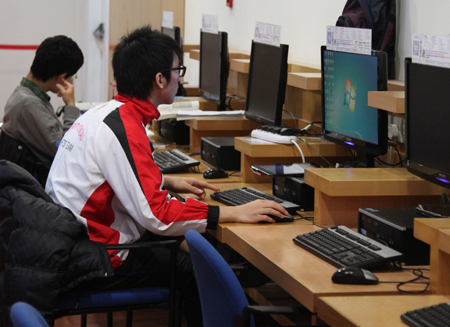For UM students who have returned to the campus after a long holiday, the first priority is course enrolment. If you are like most students who are a bit curious about the Course Enrolment System, read on.
Pre-enrolment Can Meet over 90% of the Demand
UM’s current course enrolment process includes three steps, pre-enrolment, course enrolment before the start of the new semester, and course add/drop after the start of the new semester. “Pre-enrolment lets students apply for courses they wish to study in the next semester through online registration, so that various faculties can decide how many classes to open based on the students’ demand and teaching resources,” says UM Registrar Paul Pang. “According to statistics collected over the past two years, quotas for each course decided based on pre-enrolment have been able to meet at least 90 percent of our students’ demand. After pre-enrolment, Registry colleagues create schedules with a class scheduling system which assigns students to different classes to avoid time conflicts. Before the course enrolment period starts, which is four days before the new semester opens, students already know the pre-enrolment results and schedules, and if they want to add courses or make adjustments, they can apply online within the course enrolment period and learn application results immediately.”
Paul adds: “The first eight working days after the start of the new semester is the course add/drop period, during which time students can still adjust their choices. The university arranges for students to choose courses in descending order of year of study (from year-4 to year-1). Year-1 students are arranged to do it on the last day, so sometimes they may find that certain courses they wish to study are already fully booked. We totally understand their disappointment, but unfortunately it can’t be avoided, since we have to take care of the demand of students of different years of study with the limited resources we have.” Eduarda Vu, head of Registry, adds: “Generally, there will be no problem with major courses chosen through online pre-enrolment, but it’s difficult to fully fulfill everyone’s demand for general education (GE) courses and free electives.” In the intervening time between the closing of course enrolment and the start of the new semester, faculties would add new categories or increase quotas for existing categories for courses in high demand to make sure that students can add courses they wish to study immediately after the new semester starts. Paul says the university attaches great importance to the smooth operation of the Course Enrolment System. “Examination by ICTO colleagues has found that there is basically no major problem during core hours (9:30am– 6:30pm) when students log on in batches, the problem occurs mainly during the non-core-hours when all students can log onto the system, and on two nights the system became slow for about one hour due to the sudden surge of internet traffic. ICTO colleagues adjusted the system immediately after detecting the problem. The university is also planning to invest more resources this year to increase system efficiency.
Take It Easy with GE Courses
Demand for some GE courses, first launched last academic year and are especially popular with students, cannot always be met. “Year-1 students tend to choose easy courses like PE and music first and save courses they are less interested in for later, which will lead to some courses being fully booked while others not having the required minimum number of students,” says Paul. The availability of limited teaching resources is also a problem. “Take PE and music courses for example,” says Paul. “Without sufficient classrooms and sports facilities, it’s simply hard to fully fulfil our students’ demand for these courses. We hope moving to the new campus will solve this problem.” For those who have tried without success to enrol for some GE courses, especially year-1 students, Paul advises them to take it easy and slowly, because most GE courses are available throughout the four years, so there’s no need to rush, and for the time being students can always opt for those GE courses and electives that are still available.
University Education Should Emphasise Balance and Diversity
Paul says: “Of course we need to consider the students’ demand, but as an educational institution, we also hope to expose students to a diverse body of knowledge by offering a well-balanced curriculum that covers various realms.” Vice Rector Simon Ho says: “We follow the principles of efficiency, fairness and flexibility in our current course enrolment practice, in order to meet our students’ demand to the largest extent possible with the limited resources we have.” Prof Ho indicates that there are currently two course enrolment approaches which are adopted by universities around the world—the (student) demand-driven approach and the (faculty/department) supply-driven approach. “Hong Kong universities funded by the University Grants Committee tend to have a mix of both,” says Prof Ho. “Currently UM leans towards the demand-driven approach, but we hope that in a year or two when we have accumulated more experience and data on students’ demand, we could let students select real subjects, and we hope to complete the compilation of information on committed courses, schedules and teaching staff as quickly as possible after the pre-enrolment for students’ convenience. Further down the road, we may also consider whether we should switch to the supply-driven approach.”
Many students are interested to know what course enrolment will be like after UM moves to the new campus. Prof Ho says there will be more classrooms and sports facilities, computer hardware and software will be improved (for example the processing capacity of the Course Enrolment System will increase substantially), and there will be more teachers and courses for students to choose from. UM will continue to improve the Course Enrolment System, and in the process, suggestions from students as users are always welcome.

